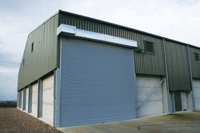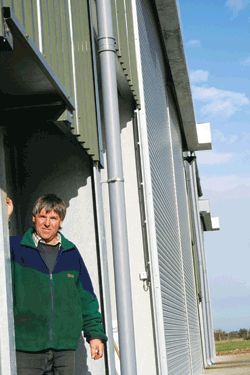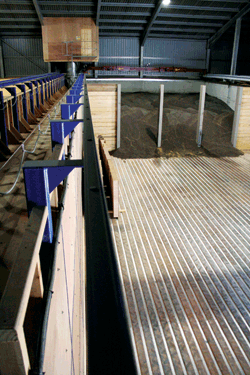Agricultural Buildings Show: Take advice before building a grainstore

When planning to invest in grain storage capacity, time spent looking at other stores can be a huge help in formulating a clear set of objectives and finding the best way of achieving them, believes Hampshire grower Chris Allen.
“I spent a lot of time looking at other stores and picking up ideas,” he says. “The design we ended up with is very satisfactory there’s nothing I’d change if we were to do it all over again.”

The Manor Farm Corn Store at Farleigh Wallop near Basingstoke replaced an old batch dryer and handling system that consumed time and cash to keep in good working order.
Long-lasting
The aim with its replacement – one of five stores available to the 1200ha (3000 acre) Fordham & Allen farming operation – was to make it as simple as possible but also flexible and long-lasting. That meant a switch to bulk drying.
“It’s all so simple instead of being held up with just 100t of wet grain capacity, we can tip, push and run during harvest and start blowing air through if necessary with relatively little grain in the store,” explains Mr Allen. “And there’s plenty of space on the extended concrete apron for tractors and trailers and big grain lorries to get to and away from the store.”
Main objectives were to have a drying and storage system that required minimal maintenance and day-to-day management and would provide the flexibility to store different crops.
“I also wanted fast intake to cope with the output of the one big combine we now operate and I also wanted more capacity,” Mr Allen adds. “We’ve also been able store everything we grow and have greater control over the way we sell it.”
Stirring system
The only disappointment comes from having to install a stirring system.
“I’d spent so much time fixing electric motors, elevator chains, conveyor belts and goodness what else in our old store that I really didn’t want any moving parts other than the doors,” he says. “I’d have preferred a slightly bigger floor space and 3m storage depth but upgrading the electricity supply to power big enough fans would have cost more than £10,000.”
Instead, grain levelled to 3.65m by telescopic handler is stirred to maintain easier airflow – and stirring does have the advantage of reducing drying times and tackling hot spots, Mr Allen acknowledges.
There are two four-auger stirring units, installed with a hoist and cross rail arrangement that enables them to work in adjoining bays – of which there are four altogether configured to reflect the cropping mix.

Two bays are for winter wheat, one is divided one-third for oilseed rape, two-thirds at the front for spring barley and the remaining bay is divided two-thirds at the back for winter barley, one third at the front for oats or linseed.
Good set-up
“As long as we don’t block in anything we want to get out first, it’s a good set-up,” says Mr Allen. “Wide roller shutter doors give us good access and because one end of each door is flush with a retaining wall, there is only one corner to shovel clean and a good width of wall for the telehandler bucket to scoop against.
Base capacity is 3000t with another 500t added by fitting door barriers, with grain, pulses and rapeseed sitting on a Hardcastle Ventacrop hardwood floor, which was constructed in place rather than in pre-assembled panels.
The two air tunnels that separate the bays are also built from hardwood rather than galvanised steel largely on the promise of easier repairs should they be damaged. Substantial “H” bracing resists the weight of the stirring system and, more especially, the thrust forces it generates.
Unusually, the fan houses are located inside the Shufflebottom galvanised steel frame building, mainly for security but also because this approach reduces fan noise and results in a tidy aspect to the rear of the building.
Storage capacity is not compromised, however, because both fan houses are suspended above the corresponding air tunnel.
Each contains a pair of axial fans, one positioned horizontally above the other, with air drawn through a silencer cowl. A modulating gas burner is mounted above the fans to provide heat when required and two fans in each of the gable and side walls extract moist air to prevent re-wetting by condensation.
Fordham & Allen crop store specification
- Capacity: 3000t at 3.65m storage depth 500t extra available with door barriers installed
- Configuration: Four 750t bays, two sub-divided one-third/two-thirds by removable plywood panels located by steel pillars with telehandler lift-out hooks
- Building: Shufflebottom galvanised steel frame Marley Eternit fibre cement roof box profile plastic coated sides Stonemark horizontal-type concrete retaining walls constructed from 6m long jointed and sealed panels
- Doors: Avon offset 6m wide roller shutters with electric drive
- Stirring: Two Rekord four-auger traversing stirrers transferable to adjoining bays
- Floor: Hardcastle Ventacrop hardwood ventilated floor with lift-out end panels for cleaning ducts.
- Air tunnels: Hardcastle hardwood structures with “H” frame bracing to resist stirrer weight and thrust
- Fans: Two sets of two contra-rotating 18.5kW stacked axial fans rated 70,000cfm @ 4in swg installed with an intake silencer cowl
- Heat: Calor gas fuelled Octagon triple burners with Octagon controller giving a choice of automated drying and conditioning regimes
- Exhaust: Six 70cm extractor fans, two each in gable and front walls
- Project: Watson & Haig Installations, Andover, Hampshire

